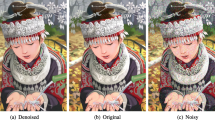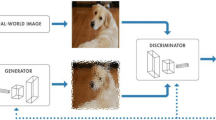Abstract
Deep learning has been widely used ever since convolutional neural networks (CNN) have shown great improvements in the field of computer vision. Developments in deep learning technology have mainly focused on the discriminative model; however recently, there has been growing interest in the generative model. This study proposes a new model that can learn disentangled representations and generate high quality images. The model concatenates the latent code to the noise in the training process and maximizes mutual information between the latent code and the generated image, as shown in InfoGAN, so that the latent code is related to the image. Here, the concept of balancing between discriminator and generator, which was introduced in BEGAN, is adapted to create better quality images under high-resolution conditions.
Access this chapter
Tax calculation will be finalised at checkout
Purchases are for personal use only
Similar content being viewed by others
References
Kingma, D.P., Welling, M.: Auto-Encoding Variational Bayes. arXiv preprint arXiv:1312.6114 (2013)
Goodfellow, I., Pouget-Abadie, J., Mirza, M., Xu, B., Warde-Farley, D., Ozair, S., Bengio, Y.: Generative adversarial nets. In: Advances in Neural Information Processing Systems, pp. 2672–2680 (2014)
Radford, A., Metz, L., Chintala, S.: Unsupervised Representation Learning With Deep Convolutional Generative Adversarial Networks. arXiv preprint arXiv:1511.06434 (2015)
Salimans, T., Goodfellow, I., Zaremba, W., Cheung, V., Radford, A., Chen, X.: Improved techniques for training gans. In: Advances in Neural Information Processing Systems, pp. 2234–2242 (2016)
Chen, X., Duan, Y., Houthooft, R., Schulman, J., Sutskever, I., Abbeel, P.: Infogan: interpretable representation learning by information maximizing generative adversarial nets. In: Advances in Neural Information Processing Systems, pp. 2172–2180 (2016)
Berthelot, D., Schumm, T., Metz, L.: Began: Boundary Equilibrium Generative Adversarial Networks. arXiv preprint arXiv:1703.10717 (2017)
Liu, Z., Luo, P., Wang, X., Tang, X.: Deep learning face attributes in the wild. In: Proceedings of the IEEE International Conference on Computer Vision, pp. 3730–3738 (2015)
Author information
Authors and Affiliations
Corresponding author
Editor information
Editors and Affiliations
Rights and permissions
Copyright information
© 2019 Springer International Publishing AG, part of Springer Nature
About this paper
Cite this paper
Kim, D., Jung, H., Lee, J., Kim, J. (2019). Improved InfoGAN: Generating High Quality Images with Learning Disentangled Representation. In: Kim, JH., et al. Robot Intelligence Technology and Applications 5. RiTA 2017. Advances in Intelligent Systems and Computing, vol 751. Springer, Cham. https://doi.org/10.1007/978-3-319-78452-6_5
Download citation
DOI: https://doi.org/10.1007/978-3-319-78452-6_5
Published:
Publisher Name: Springer, Cham
Print ISBN: 978-3-319-78451-9
Online ISBN: 978-3-319-78452-6
eBook Packages: Intelligent Technologies and RoboticsIntelligent Technologies and Robotics (R0)




